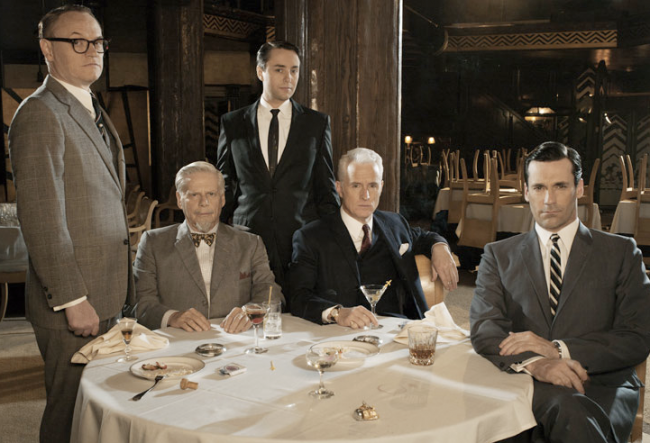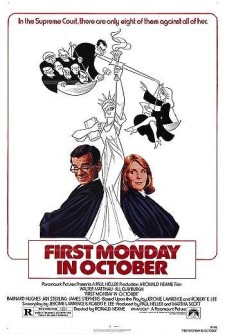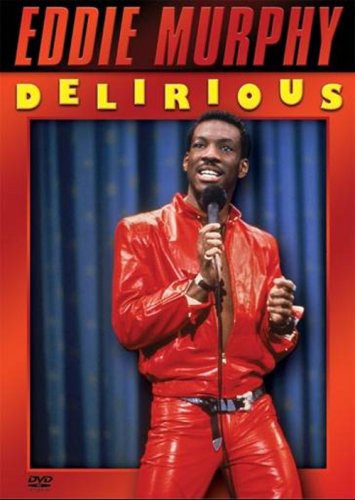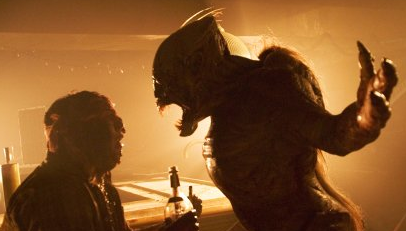Happening Now: Toasted Skin Syndrome
Your laptop will melt your balls right off, says Science. It will also give you skin cancer. There is a solution: Don’t keep it on your lap past the point where you feel like your thighs are on fire.
Footnotes of Mad Men: Charismatic Domination, or, When Daddy Is A Disaster
by Natasha Vargas-Cooper

Don! Since the beginning of “Mad Men,” all have been agog about Don Draper’s magnetism. What is it? Why do women wilt and men follow? How does his staff endure his endless floggings? (Ahem.) And how does he turn the most banal products into objects of desire? Granddaddy sociologist Max Weber provides an answer: Don is a charismatic. Charismatics draw their power from the mystic and divine. For the early Christians, a charismatic was a human vessel through which a god revealed its power. Charismatics are theatrical, eloquent, and fervent. We first saw a glimpse of Don’s supernatural power when he coolly walked around a conference table of skeptical clients and said, “Listen, I’m not here to tell you about Jesus. You already know about Jesus, either he lives in your heart or he doesn’t.” The domination of the charismatic resides in the emotional response he arouses in his followers-and, of course, in the cash that he dispenses at his whim: “The followers share in the use of those goods which the authoritarian leader receives as donation, booty or endowment.” Oh yes.
There are two other forms of this authority: traditional and bureaucratic. You can find their incarnations as well on the masthead of Sterling Cooper Draper Pryce.
Bertram Cooper serves as a figurehead for the company; a vestigial authority whose power is drawn from tradition and formality. Cooper’s right to rule is no longer based on his skill or prowess but solely due to custom. He is a monarch, priest, clan leader, a family patriarch whose authority is reinforced through myth and symbol. Weber classified traditional authority as pre-modern, feudal, but nevertheless, it’s the most popular form of government (see: world history)! What does Bert Cooper do any more exactly? It doesn’t matter! He is power because tradition is still sacred. As Weber put it, he is a part of the “the eternal yesterday.”
Lane Pryce is the model of what Weber called “rational-legal authority,” commonly known “bureaucratic authority.” The legitimacy of bureaucratic authority comes from a shared system of rules, procedures, goals with ‘members’ of the organization. Rational/bureaucratic power is stable, central, disciplined, and without personality. Indeed, they are immune to personality (“Consider me the incorruptible exception,” Lane barks at Joan when she tries to seduce). James MacGregor Burns described this sort of authority as “transactional”: an efficient transfer of rewards and punishment between followers and their leader. Weber deemed this structure modern; Alexis De Tocqueville saw this same sort of system as something much more nefarious. It is “an immense and tutelary power” that “covers the surface of society with a network of small complicated rules, minute and uniform, through which the most original minds and the most energetic characters cannot penetrate, to rise above the crowd.”
What Lane and Bert have is stability. Don’s power however is also combustible (“I WON A CLIO!”). Charisma is as volatile as the emotion that it inspires in others. Intense attraction can easily tip into intense hate and resentment. Charismatic authority is also unsustainable. A miracle worker’s fulltime job is to make miracles, otherwise his followers turn. It’s been torturous to watch Don lose his magic touch.
There is no leadership category for Roger Sterling because he is not a leader. He is a frail, collapsing charmer. Charmers have little to offer.
You can always find more footnotes by Natasha Vargas-Cooper right here, or, you know, you can get a whole book of ‘em.
The Gold ATM Comes to America

It is, perhaps, the logical sequel to a decade in which Americans were encouraged to use their homes as ATMs: the recent announcement that next month will see the debut of the first gold-dispensing ATMs in the United States. As any casual Glenn Beck viewer will tell you, the gold market is booming; the metal eclipsed the $1,300-an-ounce threshold recently, the highest price it’s reached in history. That’s nearly double the price it fetched in 2008, and nearly four times its price when the current gold craze took off in the early aughts.
And the appearance of machines dispensing shiny yellow little bars and Krugerrands is, for some investment savants, every bit the warning sign of a bubble’s wooze-inducing liftoff that the ARM-happy mortgage market was back in the day-back when restaurant workers and cab drivers began giddily flipping houses.
But the company that’s pioneered the Gold-to-Go dispensaries-a German concern called Ex Oriente Lux (“The Light From the East”)-contends, on the contrary, that it’s peddling the only form of financial surety out there.
“There is virtually no other form of investment, that is equally as anonymous, transportable and accepted worldwide as a value conservation and payment method, as physical gold,” writes the firm’s lead theorist, “Aureus.” And for good measure, he waves away recent talk of an ascendant gold bubble with an anecdotal appeal: If we can more readily summon up the names of 20 holders of paper securities than we can tick off just five rock-solid gold backers, why then there’s no cause for alarm. Indeed, the very scarcity of the commodity-which is what prompts investors to flock to it at as hedge against inflation and soft money in the first place-argues against a serious bubble ever forming. “How should a bubble even develop,” Aureus asks, “when all gold produced so far fits into a cube of about 19 meters edge length? There is simply no valve on it to blow it up.”
So the idea, it seems, is for on-the-go investors suddenly seized with a Beck-like vision of civilization’s epic collapse, and the mass conflagration of the feckless fiat currencies of nation states and trading blocs, can pop over to an ATM for a quick metallic pick-me-up. It’s much the same process, one supposes, by which bleary, battle-fatigued clubbers slouching toward closing time can stoutly fortify themselves with a vodka-and-Red-Bull.
There’s just one problem with the theory, though: Gold really isn’t an asset, in the conventional sense of the term, at all. It is, rather, another sort of currency, whose value does indeed spike during times like the present, when governments contract enormous debt and investors grow anxious about how resulting inflationary pressures will devalue their holdings over time. Unlike silver, which is also likely on the verge of its own bull rush, gold has very few industrial applications, and jewelry-the only other real use the world has for the stuff-is actually showing a steady decline in gold demand.
So the gold market, far from serving as the sanest shelter amid broader market storms, is itself an unstable compound of investor superstition and fear. That’s how famed Gilded Age con artists like Jay Gould and James “Diamond Jim” Fisk were able to exploit skittish investors to try to corner the gold market-and thereby precipitated the great “Black Friday” financial panic of 1869. It’s also why, at the outer reach of the panic begun in 1893, the uber-banker JP Morgan was able to cow the Cleveland administration essentially into handing over the US Treasury’s gold operations to Morgan’s own global consortium of private bankers. Even the present bull market for gold issues in part from the artificially low price the metal fetched at the end of its two-decade bear market in 2000–2001; as the Wall Street Journal’s Brett Arends notes, gold lost 80 percent of its purchasing power between 1980 and 2000. The idea of a perma-bull gold market-the de facto faith of today’s gold champions-is just as illusory as the belief in the metal’s supposedly transcendent value.
Most of these deeper signs of market distress can be descried in a closer look at the Gold-on-the-Go product launch strategy. The ATMs made their debut in May at the $3-billion Emirates Palace Hotel in Abu Dhabi-certainly a fitting venue to dramatize the whole “Light from the East” catchphrase, but a far cry from the kind of poster child for financial stability that today’s goldbugs would want it to be. The United Arab Emirates-the battered former investment playground for the monarchies of Abu Dhabi and Dubai — is now the slowest-growing economy in the Middle East, thanks largely to the vast amount of toxic debt that the state-run Dubai World concern foisted on its Abu Dhabi creditors. (The UAE’s exposure in the Greek debt implosion certainly hasn’t helped matters, either.) The firm is also slated to expand into Russia-because, well, what could possibly go wrong in that ATM sector?
The same gimlet-eyed sense of market-scouting is guiding the Ex Oriente Lux strategy on Yank shores, as well. The firm hasn’t definitively announced the proud specific venues for the stateside debut of its ATMs, yet, but does allow that the gizmos will be sited at a “well-known Las Vegas casino” and a Florida resort. Yes, that would be the same Las Vegas that, according to yesterday’s sobering New York Times dispatch by Adam Nagourney, is suffering a 14.7 percent rate of unemployment, while as of August, Nevada had led the nation for the 44th consecutive month in its volume of home foreclosures. Florida, meanwhile, boasts the nation’s 45th-lowest income-and has been in recession far longer than most of the rest of the country. It is the runner-up to Nevada in the national home-foreclosure sweepstakes, and as national economists officially declared the recession officially over this month, the state experienced yet another spike in unemployment.
On one level, I guess it’s understandable that footloose global investors traipsing through Vegas or Boca Raton might feel a strong urge to fortify their sagging morale with an on-the-go dose of gold as their towncars glide through foreclosure-ravaged neighborhoods and jobless encampments as they come and go from the airport and their resort/casino of choice. But they might also do well to reflect that Ex Oriente Lux has for some reason chosen to adopt as its slogan a quotation from Goethe’s Faust: “Toward gold throng all, to gold cling all, yes, all!”
Those, you see, are the words that Faust’s love interest, Margaret, utters as Mephistopheles engineers her seduction by Faust via the vessel of a chest stuffed with gold jewels. That would be the seduction that set Margaret on a path of unendurable suffering, and eventual renunciation of the world. Indeed, even after Margaret’s expostulation thrilling to the wonders of the metal, Goethe has her foreshadow her fate with the words “Alas, we poor!”
Chris Lehmann’s book, Rich People Things, is available now for pre-order! “Social criticism at its scorching-hot best,” says Barbara Ehrenreich!
Berlusconi Jewish Joke Unappreciated
“The Jew says, the question now is whether we should tell him Hitler is dead and the war is over.”
-Italian Prime Minister Silvio Berlusconi, who has locked down the Hitler comedy beat, was condemned by the Vatican yesterday for telling a Holocaust joke about a Jew who ‘agreed to hide another Jew in his cellar but forced him to pay more than $4,000 a day because ‘we are Jews.’”
Most Exciting Cases Of The New Supreme Court Term
by Natasha Vargas-Cooper

All case summaries via SCOTUSblog.
16. Snyder v. Phelps: “Does the First Amendment protect protesters at a funeral from liability for intentionally inflicting emotional distress on the family of the deceased?”
15. General Dynamics Corp. v. United States: “Whether the government can maintain its claim against a party when it invokes the state-secrets privilege to completely deny that party a defense to the claim.”
14. Federal Communications Commission v. AT&T;, Inc.: “Whether Exemption 7(C) of the Freedom of Information Act — which exempts from mandatory disclosure records or information compiled for law enforcement purposes when such disclosure could reasonably be expected to constitute an unwarranted invasion of ‘personal privacy’ — protects the ‘privacy’ of corporate entities.”
13. Schwarzenegger v. Entertainment Merchants: “Does a state law restricting the sale of violent video games to minors violate the First Amendment right to free speech?”
12. Sykes v. United States: “Whether using a vehicle while knowingly or intentionally fleeing from a law enforcement officer after being ordered to stop constitutes a ‘violent felony’ under the Armed Career Criminal Act”
11. Staub v. Proctor Hospital: “Can an employer be found liable for the discriminatory acts of supervisors, who do not themselves make employment decisions but do influence the employment decision-makers?”
10. Cullen v. Pinholster: “Whether a federal court can overturn a state criminal conviction on the basis of facts the defendant could have alleged, but did not, in state court.”
9. Bruesewitz v. Wyeth: “The National Childhood Vaccine Injury Act protects vaccine manufacturers from liability for certain injuries caused by their vaccines (giving injured patients compensation from the government instead). Does that immunity apply when the victim claims that the design of the drug created an avoidable and unnecessary risk to patients?”
8. Michigan v. Bryant: “The Sixth Amendment generally requires prosecutors to present testimonial evidence through live testimony at trial. Do statements made by a wounded crime victim to police officers about the perpetrator constitute such testimonial evidence, or can the police officer testify at trial about what the victim said?”
7. Kentucky v. King: “Under what circumstances can lawful police action impermissibly ‘create’ exigent circumstances that preclude warrantless entry?”
6. Premo v. Moore: “When a defendant has pleaded guilty, but later challenges his conviction on the ground that his lawyer should have moved to suppress his confession, is he entitled to habeas relief upon showing that his confession was coerced?”
4. Pepper v. United States: “May a court consider a defendant’s post-sentencing rehabilitation as a ground for reducing his sentence below the federal sentencing guideline range? When a sentence is vacated on appeal, and a new judge is assigned on remand, must the new judge follow the prior district judge’s sentencing findings?”
3. Virginia Office for Protection and Advocacy v. Stewart: “Does the Eleventh Amendment prohibit an independent state agency established to protect individuals with disabilities from suing state officials in federal court to obtain a court order requiring the officials to comply with federal law?”
2. Skinner v. Switzer: “When a convicted prisoner wishes to sue a state to obtain access to biological evidence for DNA testing, is he required to file a habeas petition or can he file a civil rights suit instead?”
1. Connick v. Thompson: “Can a prosecutor’s office be held liable for the illegal conduct of one of its prosecutors, on the theory that the office failed to adequately train its employees, when there has been only one violation resulting from that deficient training?”
Natasha Vargas-Cooper is passionate about the law. And “Mad Men.”
Kanye West Continues Being Supremely Awesome
https://www.youtube.com/watch?v=O-jr8ft7br8
You’ve probably seen this. But just in case you haven’t: here’s Kanye West performing his new song “Runaway” with a ballet troupe and Pusha T on Saturday Night Live. Against a heavenly white-draped set (that’s my big question: was this in fact in front of the studio audience, or fed in on a screen? I hope people got to see it live), dressed like Eddie Murphy in Delirious, Kanye proved why he’s the most captivating pop star on the planet right now. He also performed “Power,” with choreography reminiscent of the nude album cover of Jimi Hendrix’s Electric Ladyland. That was terrific, too. But since “Runaway” came out a couple weeks ago, I just can’t stop listening to it. It’s so defiant and sad all at the same time. It’s like a hip-hop “Behind Blue Eyes.”
Not kidding about the outfit.

Or the comparison to The Who.
Things Visible in the Windows of the Apartment Building Across the Way
by Anonymous

10. A man with a shaved head, wearing a white hooded robe with black stripes, doing arm exercises.
9. Movie credits playing on a television the size of an entire wall.
8. A young woman and a small fluffy tan dog, napping together on top of the bedcovers.
7. A medium-young man, not particularly fit, sitting shirtless at a computer all day and into the night.
6. Two workers with a stepladder, repainting an empty unit.
5. A young man and woman at their bed, at lunchtime on a weekday; his feet on the floor and her feet behind his ears.
4. A bamboo plant turning yellow.
3. A young woman in a housedress, pushing her face out the window to smoke a cigarette.
2. A woman rising and dressing for work. A man, in the same window, rises three hours later and gets on his computer.
1. A man in a dress shirt and tie, looking at my building with binoculars.
Anonymous lives, obviously, in New York City.
Photo from Flickr by William J Sisti.
Reading The Polls In The NY Gov Race
Reading the tea leaves: “Here are some other categories of people who told Marist they preferred Cuomo to Paladino: white people, nonwhite people, poor people, middle-income people, rich people, people younger than 45, people 45 and older, men, and women.”
Man Fired For Touching Woman On the Job (While They Are Strapped Together)

It’s a lawsuit for the ages: this “100% gay” guy is suing his former employers after he was terminated for touching a female student “in a way that made her uncomfortable.” LET’S GET HIM! Oh, also he was her tandem skydiving instructor at the time of the touching and they were jumping out of a plane.
31 Days of Horror: "Feast"
by Sean McTiernan

It’s a case of adjusting expectations and panning for gold. When you watch a gross of horror movies (pun intentional, apology available upon request) you probably shouldn’t be looking for cinematic excellence. It can happen, as we’ll learn as we progress in the coming weeks, but more often than not you’re being surprised by the occasional good or incongruous element rather than dazzled by a cohesive piece of art.
For instance, there’s a movie called “Home Sick” I was going to cover for this series. But when I rewatched it I realized all it had going for it was one incredible scene at the start, where a grimacing menace in a barbershop suit arrives and self-mutilates while taunting a crowd of grunger (shouts to the guy’s High On Fire shirt). It’s unsettling, creepy, original and portrayed perfectly by Bill Moseley, a man whose vocation is to play psychopaths (he certainly doesn’t do it for fun: watch the Making-Of documentary for Devil’s Rejects and see him be genuinely creeped out by almost everything his character has to do). You can watch it here, if you don’t mind self-harm and wildly varying levels of thespian ability.
Sadly the rest of the movie is pretty rough, the most memorable violence being the headwounds each actor surely must have received to help them deliver such uniformly woozy performances. If you want more through review of “Home Sick,” and far realer talk than I could ever provide, take in this video or if you really want to get down: this one. (Oh and dudes who made “Home Sick”: I know, this is a lame google alert to get and I’m sorry. Good luck in the future!)
Today’s movie is a perfect example of both unexpected levels of inspiration and a brief section of quality in an otherwise lackluster movie. “Feast” never looked like it was going to be any good. If the main purpose of your movie is to have a reality show about the filming process be made, your hopes should not be that high. If you’re pushing Jason Mewes’ cameo (yeah, that’s a spoiler, I’m not your mom, I can’t be looking after you the whole time) as one of your big sells: you’re probably in trouble. I would say if your whole cast is a mix of the risible and the invisible you’re in trouble but I think that just makes you a horror movie. The point is: hope was not alive for this movie when I began watching it.
But I quickly discovered I had severely underestimated the moxy and ingenuity of the film makers involved. For around eighteen minutes. Then they spend the last hour of the movie aggressively meeting any assumptions of mediocrity on the part of the skeptical viewer.
But man, those first eighteen minutes. “Feast” manages, against all odds, to break out of the gates at a gallop. The opening shots of the movie introduces all the characters, gives their stereotype and relates their chances of survival. This manages to hit just the right tone, playing on the audience’s horror knowledge and being just obnoxious enough not to come across as too obvious. From then on the characters act the right side of irredeemable, the dialogue has just enough cheesy zings and silly cliches. Even the normal protocol for hurriedly setting up how characters relate to each other has exactly the amount of pie you would like shoved in its face-shoved right in its bloated face. Even the small attempt at actual tortured back story for the eventual heroine can be played off as parody if you close your eyes and wish hard enough.
The violence stars pretty early and initially is of the madcap “Evil Dead 2” variety. The gore flows freely, and “Feast” features probably one of the most bled-on characters in movie history, and has just enough of a Street Trash-esque edge. You genuinely can’t tell who’s going to die and the switch around around the 13 minute mark will get new viewers every time. It’s kind of inevitable but still delivers the roundhouse that the preceding mania has been building up to.
Had “Feast” ended there, tacked on either an open-ended, looking-into-the-distance-into-the-face-of-danger conclusion or even a mildly acceptable twist ending (eg EVERYONE IS LIVING IN A PHOTOGRAPH AND THE MONSTERS ARE THE NEGATIVES OH MY GOD!) I won’t need to be telling you about it. They’d be teaching it in schools in a class entitled “See? There’s Still Options For Shlock Horror.” If you added another two stories, even weak ones, and it could have singled-handedly revived “Creepshow”-style omnibus horror movies. (“Trick R Treat” should have done this anyway, but was destroyed by the studio.)
But they didn’t. Tellingly, when Judah Freelander and Henry Rollins start getting more and more lines of dialogue, disaster strikes. No two men could better embody both poor acting and over-egging their respective modest puddings. That’s when the buckets of self-awareness and goofy splatter, which had been masterfully balanced until then, fall off the “Feast” see-saw and soak everyone. The movie starts to insult your intelligence and, an even worse sin, to take itself seriously. Sure, I guess that level of winking parody probably couldn’t have been sustained over an entire move but the Troma people manage to base entire movies on shouting so at least you could have tried, guys. But instead there start to be more and more scenes were you’re supposed to be feeling dramatic tension but the characters do nothing to support this.
Henry Rollins goes from being a nerdy cowardly business man (get it folks! RISE ABOVE right?) to parodying a character that does not really exist in horror movies anymore, only in Scooby Doo and a Dave Chappelle joke. Look I really love Black Flag. And who among us would begrudge a man his dream to stand on stage and talk about how nice a guy Ian MacKaye is and how sometimes politicans are mean? But who is giving Henry Rollins movie roles? It has just occurred to me that I could be misinterpreting things. Maybe the character of the caddish lame businessman at the start of the movie is a meta-commentary on what Rollins has become? The silver wedding ring he initially hides could represent his profit-hungry core, hidden from the innocent waitress of middle-aged, black-hoodied punk fans. Then when he morphs into the second character, the gung-ho cliché who makes dramatic, pompous speeches about why he’s important but then slinks into the background when push comes to shove. Maybe this is another meta joke about how he was in “Get In The Van”? Nah, it’s totally not. Really I like Henry fine, I just dislike when he gets his wooden acting all up in my face.
The decline is not just because of Rollins and Freelander’s hammy turns. The unexpected deaths become heavily telegraphed and as predictable as if klaxons were sounding ten seconds before they happen.The humor devolves into weak “oh man look, monster dick” sight gags (this is great when done right, it’s half-assed here) and crosses the line straight into desperate, lame grossness. The story deteriorates further and further the more seriously it begs you to take it. It’s a hot mess folks, and a shameful waste of the promise made by the opening salvo.
So if you do get “Feast,” and you should, only watch the first 18 minutes. It’s hilarious, its conjurors TV’s greatest atmosphere (80s Twilight Zone) and you could easily make up and ending in your head if you wanted. Oh and the sequels are unwatchable and the music could be the worst movie music since “Heat” (revisit it: aside from Moby, it’s a disaster!). But still, those 18 minutes are worth your time.
Sean Mc Tiernan is 21, his favorite rapper is E40 and he wants to assure you he does sometimes go outside. He has a blog and a twitter. So does everyone though. He also has a podcast on which he has a nervous breakdown once an episode, minimum.You should totally email him with your questions / insults/ offers of tax-free monetary gifts.
